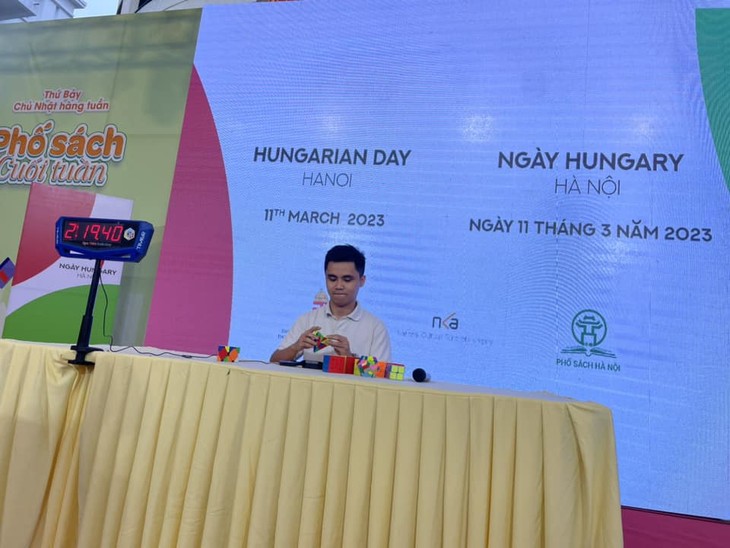(VOVWORLD) - What do you know about the culture of Hungary, a landlocked country in central Europe? A generation of Vietnamese studied and worked in Hungary and knew the country quite well. But it was a long time ago. To make Hungary more familiar to Vietnamese people, especially the youths, Hungary Day 2023 was held in Hanoi last weekend.
 “Budapest Bár” performs on Hungarian Day 2023 in Hanoi Book Street (Photo credit: Embassy of Hungary in Vietnam) “Budapest Bár” performs on Hungarian Day 2023 in Hanoi Book Street (Photo credit: Embassy of Hungary in Vietnam) |
Hungarian Day 2023 was part of activities to mark 73 years of diplomatic relations between the two countries. The cultural event provided an exciting opportunity for Vietnamese and foreign visitors to explore Hungarian education, creativity, music, and gastronomy.
One of the highlights of this year’s event was a performance by Hungarian band “Budapest Bár”, whose repertoire stretches from Liszt through 1920s European songs to Michael Jackson covers, according to Andrea Gancs, the band’s manager.
Andrea said the band’s music is based on a tradition at the beginning of the last century, in the 1920s, 1930s.
“There was a big nightlife in Budapest, in cafes and restaurants there were a lot of gypsy bands playing. It's not traditional folk music. They played every kind of music - jazz, operetta, and popular songs. It's an urban tradition, not a folkloric tradition. And they played classical music,” Andrea recalled.
“So Budapest Bar is based on this tradition. We play different styles of music, jazz and Hungarian songs, but also light classical music in a more modern arrangement,” according to Andrea.
The trio - bandleader RÓBERT FARKAS, the violinist; KÁROLY ÖKRÖS, the pianist; and TANIA SAEDI, the Austrian-Persian singer and flutist - are all masters of their art, who bring together choice compositions, technical highlights, improvisational drive, and musical fantasy of the highest order with natural ease.
 Super brain Vietnam Nguyen Ngoc Thinh demonstrates Rubik's cube at the Hungarian Day 2023 in Hanoi (Photo credit: Embassy of Hungary in Vietnam) Super brain Vietnam Nguyen Ngoc Thinh demonstrates Rubik's cube at the Hungarian Day 2023 in Hanoi (Photo credit: Embassy of Hungary in Vietnam) |
Another highlight of Hungarian Day 2023 was a demonstration of the Rubik’s cube, invented by Ernő Rubik, a professor of architecture from Budapest. 26 small cubes rotate on a central axis in three rows of three.
The cube is twisted out of its original arrangement, and then the player tries to return it to its original configuration, one of 43 quintillion possible configurations!
The toy was popular in Vietnam in the 1980s and its popularity is reviving through many school clubs and competitions.
On this cultural day, the Rubik’s cube demonstration by super brain Vietnam Nguyen Ngoc Thinh attracted a huge audience.
Thinh told VOV that he has been playing Rubik's cube for many years. “I’ve found that this game helps me a lot in geometry and logical thinking. To solve a Rubik’s cube, you have to do one layer at a time. If you don’t follow logical thinking, you won’t be able to solve it,” said Thinh.
He insisted that in fact, it’s very easy to solve a Rubik’s cube. It takes about 30 minutes to learn how to solve the 6-sided cube. But to play fast is more difficult, requiring you to know many algorithms and how to apply those algorithms to solve the Rubik’s cube in the optimal way, said Thinh.
 Hungarian Goulash is a delicious beef stew (or soup) with a rich paprika seasoned broth. (Photo credit: Embassy of Hungary in Vietnam) Hungarian Goulash is a delicious beef stew (or soup) with a rich paprika seasoned broth. (Photo credit: Embassy of Hungary in Vietnam) |
It’s a mistake to talk about Hungary without mentioning food and beverages, to which Hungarians feel a strong cultural attachment.
Hungarian gastronomy is characterized by both tradition and innovation, which were introduced on Hungarian Day by involving the five senses in the discovery of traditional food all day long.
One dish loved by both Hungarians and foreigners is goulash, one of the national dishes of Hungary and a symbol of the country.
Goulash, which dates back to the 10th century, is a soup or stew of meat and vegetables seasoned with paprika and other spices. It is a common meal predominantly eaten in Central Europe but also in other parts of Europe.
Ali Waugh, the owner of the Slavic Tea House and the Eastern and Oriental Tea House and Coffee Parlour in Hanoi, said that lots of Slavic countries have goulash. Although Hungary is not a Slavic country, it’s located in the area where many Slavic countries are.
“Hungarian goulash is different from other countries. Poland has their own goulash and Ukraine certainly has their own goulash. They often make it with pork, not just beef, and also chicken, and also it's more of a stew than a soup in those countries. So, if you're having a Hungarian goulash, you know it's authentic because it's a soup,” said Ali.
Music, Rubik’s cube, and cuisine are just among many things to portray the unique cultural landscape of Hungary. And to further popularize the Hungarian culture in Vietnam, especially among the younger generation, more similar events should be organized.